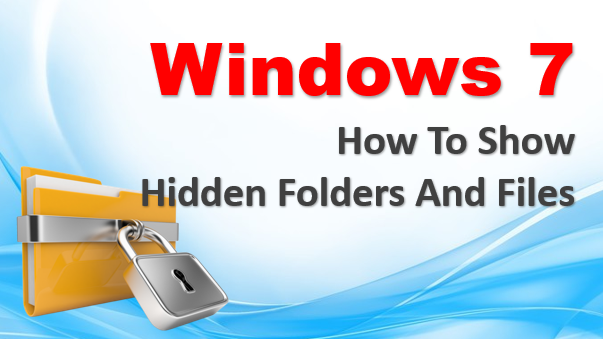
- #DISPLAY WINDOWS 7 HIDDEN FILES FOLDER HOW TO#
- #DISPLAY WINDOWS 7 HIDDEN FILES FOLDER PC#
- #DISPLAY WINDOWS 7 HIDDEN FILES FOLDER WINDOWS#
Bring up the search feature on your taskbar, type in “command prompt”, then right-click the top result and select the Run as administrator option.
#DISPLAY WINDOWS 7 HIDDEN FILES FOLDER HOW TO#
Here are the instructions on how to unhide files or folders using Command Prompt:
/d to apply the attribute action to any files and subdirectories within the directory you’re on. -h to remove the hidden attribute from a file/folder. It is used in conjunction with the following syntaxes: You’ll have to learn a few commands and what they do, but it’s worth the trouble.īefore you start using this method, you should know that the main command you’ll be utilizing is the “attrib” command which allows you to add or remove certain parameters to specific files or folders. You can remove the hidden attribute directly from the file/folder while it’s still hidden. The good thing about using Command Prompt to unhide your files or folders is that you won’t have to reveal all your hidden files first to edit their attributes. You can now stop showing all your hidden items once more and the file or folder you edited should remain visible. Your file/folder should now have the hidden attribute removed. Once you make your decision, click the OK button to proceed. If you’re unhiding a folder with various hidden files housed within it, another pop-up window will appear asking if you want to unhide just the folder or the files inside it as well. Uncheck the Hidden checkbox near the bottom of the window and click the Apply button. Right-click the file or folder and select the Properties option. Navigate to the file or folder that you want to unhide. #DISPLAY WINDOWS 7 HIDDEN FILES FOLDER WINDOWS#
Click the folder icon along your Windows taskbar to bring up the File Explorer window. Once you’ve accomplished that, follow the steps below: 
Windows File Explorerįor this method, you’ll need to first make all of your hidden files and folders visible using the technique outlined in the previous section. You can either use Windows File Explorer which is the more user-friendly and easier of the two methods, or you can utilize the Windows Command Prompt tool which requires you to be familiar with a few sets of commands. If you’d rather not reveal all of your secret files and are interested in unhiding just a select number of hidden files or folders, then there are a couple of ways you can go about this. Uncheck the box and click the Apply button to reveal all your important system files as well. Head to the View tab and scroll down a bit until you see the Hide protected operating system files (Recommended) checkbox. If you know what you’re doing and are dead set on accessing these files, you can click on the Options dropdown in the top-right corner of the Window and select the Change folder and search options.
Your hidden files should now be visible except for protected system files that Windows doesn’t want you messing around with. Navigate to the View tab on the top-left corner of the window. Open up an instance of Windows Explorer by clicking on the folder icon on your Windows taskbar. Just follow the simple steps below on how to find hidden files on a computer using File Explorer: It’s worth noting, however, that this method makes ALL the hidden files on your machine visible. It’s actually really easy to access, as long as you know where to look. Windows operating systems have an option built into its Windows File Explorer tool that allows you to toggle the visibility of hidden files on or off as you see fit. How to Show All the Files in File Explorer In this guide, we’re going to teach you how the hiding feature works in Windows and help you recover hidden files that have been lost or compromised. 
Just like any other form of data, hidden information is susceptible to various forms of data loss.
#DISPLAY WINDOWS 7 HIDDEN FILES FOLDER PC#
Reading Time: 8 minutesHiding files on your Windows PC is a good way to keep important and confidential information away from prying eyes, as well as being one of the methods the operating system uses to prevent users from accessing delicate system data that’s integral to the operation of the platform.






 0 kommentar(er)
0 kommentar(er)
